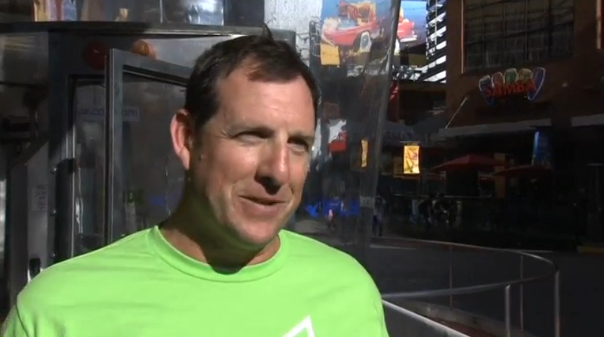
LOS Angeles, California, USA (Reuters) — To many, doing a parachute jump is their greatest fear. However, renowned American skydiver Luke Aikins is about to go one further and jump out of a plane without a parachute.
Speaking at a media event on Monday (July 11), Aikins said, “Well, we’re jumping from 25,000 feet, we’re going to free-fall for about two minutes before we land and I’m going to land without a parachute, I’m going to land without a parachute, I’m going to land and get up and walk away without a wingsuit, a parachute, no nothing.”
The married 42 year-old added “I’ve been jumping for about 26 years. I have about 18,000 jumps. I’ve got to work on a lot of big projects where I’ve got to help with some engineering so all that practice and all that training… basically my whole life has been building to something like this.”
Aikins, however, will be landing in something which organizers would only describe as a kind of ‘slide’. When asked about his landing, he replied, “So that’s a big drama. Everyone wants to know what we’re going to land in and what I’m here to tell you is we’re going to land in something, I need to land on my back. This device has been tested. We’ve been dropping stuff from helicopters from 1000 feet — a dummy, just like me – and it catches it and it slows it down and the g-forces are right around four and a half to five gs, that’s all for about one and half second you slow over and I slow down roughly over around 150 feet.”
“The absolute variable in all of this is wind. You’ve seen we’re in this wind tunnel here and we’re flying around but the wind is going straight up – there’s nothing pushing from the side – so as soon as you get that outside wind influence it starts to push you, now I have to counter it so I have to drag on one side and force myself to drive into the wind a little bit and that wind changes in different layers all the way down so just a little bit of wind…. if it’s blowing at 10 miles per hour, that’s going to want to slide me at 5 miles per hour away from where I’m trying to be so I have to fight that and drive into the wind so the wind is definitely my biggest adversary in all this,” he continued.
The stunt is scheduled to be shown live on Fox in a one hour special on July 30th in an event called ‘Stride Gum Presents Heaven Sent’. And as far as worries go, Aikins has one main concern.
“The absolute variable in all of this is wind,” he explained. “You’ve seen we’re in this wind tunnel here and we’re flying around but the wind is going straight up – there’s nothing pushing from the side – so as soon as you get that outside wind influence it starts to push you, now I have to counter it so I have to drag on one side and force myself to drive into the wind a little bit and that wind changes in different layers all the way down so just a little bit of wind…. if it’s blowing at 10 miles per hour, that’s going to want to slide me at 5 miles per hour away from where I’m trying to be so I have to fight that and drive into the wind so the wind is definitely my biggest adversary in all this.”
Aikins, who took on the jump after discussing it with his skydiving wife, has been practicing by getting a special permit to carry out parachute jumps beneath the legally enforced height.
But how does he feel about carrying out this death-defying stunt?
“I think it would be ridiculous to do something like this without thinking about it and being nervous about something like this. I’m going to do something that’s definitely out there and most people in the world will think is crazy but what I like about it is that when you see all the science and all the math and all the engineering that goes in behind this thing, from a physics stand point, I mean we stop cars – racecars stop all the time. They weigh a lot more and go a lot faster and stop at a shorter distance so I’m applying some of those physics to see if this is possible,” he said.
Aikins also has a team of scientists developing the landing contraption as well as Michael Gervais, a high performance psychologist who helps people in high risk situations.
Gervais was also at the media event and explained “This project represents something for all of us about risks, about taking chances, about living fully and it forces us to examine our own temperance (temporarily) in life and how any permanence in the temporary nature of life is real and so for him to face that and not just one day think about it that he will die – that’s a real part of the conversation – we’re planning to train his craft, his body, the structure of the environment of his mind to mitigate anything that could possibly go wrong and if it does, he’s prepared.”
Aside from the live television broadcast, the jump will also be streamed online and on pay-per-view internationally.






